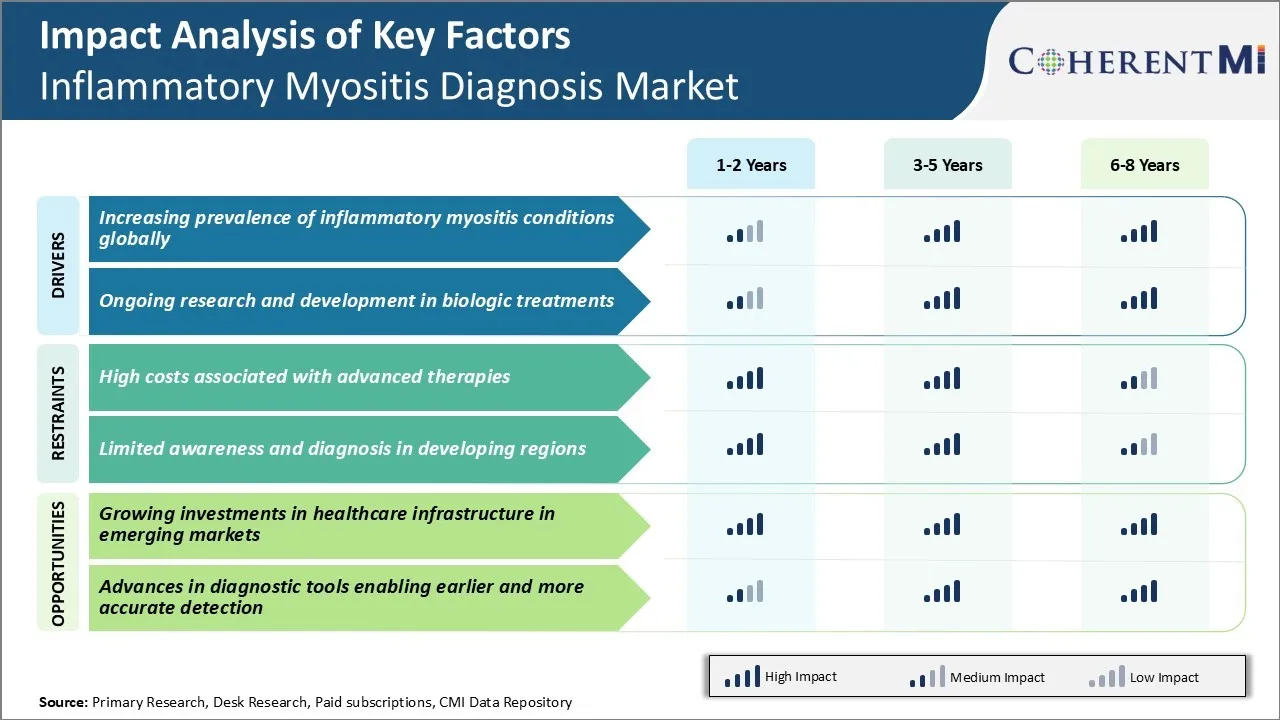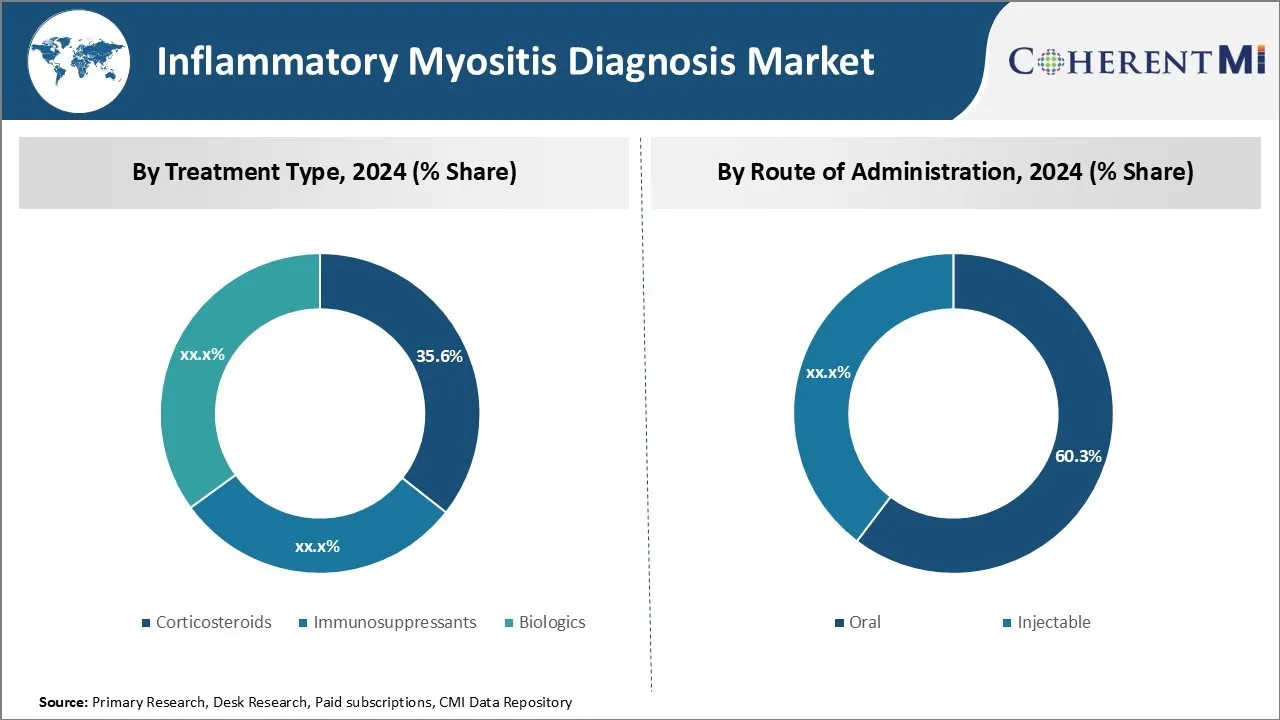염증성 근염 진단 시장 크기 - 분석
USD 기준 시장 규모 Mn
CAGR6.00%
| 연구 기간 | 2025-2032 |
| 추정 기준 연도 | 2024 |
| CAGR | 6.00% |
| 시장 집중도 | Medium |
| 주요 플레이어 | 회사 소개, Novartis AG, 이탈리아, 스낵 바, 브리스톨 마이어스 Squibb, (주)아비비 및 기타 |
저희에게 알려주세요!
염증성 근염 진단 시장 트렌드
Market Driver - Biologic 치료의 Ongoing Research 및 개발
항염증제 자원은 현재 항염증제 myositis 장애를 위한 새로운 생물 논리 치료법을 개발하기 위해 지시됩니다. 이러한 조건의 복잡성 및 이질성, 기존 제약 개입은 종종 제한된 성공률이 있습니다. 안전, 표적 및 오래 견딘 처리 선택권을 위한 아직도 unmet 필요 있습니다. 따라서, biologics 연구에 있는 진보는 대중과 개인적인 펀딩 몸 둘 다에서 강한 지지를 계속합니다. monoclonal 항체, fusion Proteins 및 기타 생명 공학 약을 포함한 Biologics는 autoimmune 질병을 관리하고 현재 가장 적극적인 치료약을 나타냅니다.
많은 생명 공학 및 제약 회사는 특정 염증 통로, 면역 세포 신호 또는 세포 골격 근육 염증 병상에서 단순화 된 특정 염증 경로, 면역 세포 신호 또는 세포 골격을 막기위한 임상 평가를 진행했습니다. 관련 류마티스 질병에 대한 생물학의 규제 승인은 개념의 증거와 염증성 myopathies에 있는 생물학의 신청의 더 탐험을 제공했습니다.
Biologics 개발은 성공 uncertain와 긴 그림 과정이지만, 모션의 수많은 사전 클리닉 및 임상 프로그램은 생명 공학을 통해 더 효과적인 치료를 개발하는 데 기여합니다. 시험에서 긍정적 인 결과는 분자의 표적 생물 공학을 특징으로하는 새로운 표준화 된 치료 프로토콜의 라이센싱 및 상용화로 변환 할 잠재력을 가지고 있습니다. 이러한 진보는 염증성 myositis 환자에 대한 삶의 질과 개선 된 관리 약속.

Market Opportunity - Emerging Markets의 헬스케어 인프라의 성장 투자
염증성 myositis 진단 시장은 신흥 시장의 의료 인프라 개발에서 성장하는 투자로 인한 실질적인 성장 기회를 목격하고 있습니다. 수많은 선진국의 정부는 최근 몇 년 동안 의료 시스템을 현대화하고 확장하기 위해 노력하고 있습니다. 이것은 진단 서비스, 장비 조달 및 실험실 인프라 개발을 위한 큰 예산 할당을 포함합니다.
목표는 진단 의료를보다 저렴하고 일반 인구에 접근 할 수 있도록하는 것입니다. 결과적으로 공공 및 민간 진단 센터 모두 증가 된 투자를보고 있습니다. 신흥 시장에서 이 성장하는 진단 인프라는 염증성 myositis 진단 시장에서 플레이어에게 수익성을 제공합니다.
회사는 이 지역의 요구 사항에 따라 제품 및 가격 전략을 맞춤화하여 이러한 개발 시장을 탭 할 수 있습니다. 이것은 지구 염증성 myositis 진단 수요의 더 큰 공유를 얻는 것을 도울 것입니다.
처방자의 선호도 염증성 근염 진단 시장
Inflammatory myositis는 전형적으로 질병 severity 및 진도에 근거를 둔 단계 현명한 처리 접근을 따릅니다. onset에 온화한 케이스를 위해, 그것의 유력한 항염증제 효력을 위한 prednisone와 같은 corticosteroids에 일반적으로 의존합니다. 증상이 지속되면 methotrexate (Rheumatrex)와 같은 스테로이드 비교 면역 억제제가 추가 될 수 있습니다.
온건한 빈 질병을 위해, 처방전은 수시로 glucocorticoids와 immunosuppressants를 가진 조합 치료를 개시합니다. 대중적인 선택은 methotrexate, mycophenolate mofetil (CellCept), 또는 azathioprine (Imuran)를 가진 prednisone를 포함합니다. Intravenous immunoglobulin (Gamunex, Privigen)는 대체 첫 번째 선 접근 방식을 제공합니다.
불균형의 경우, 특정 면역 공정을 대상으로 한 biologics는 옵션이됩니다. 종양 necrosis 인자 억제제 infliximab (Remicade)와 adalimumab (Humira)는 빈번한 사용법을 봅니다. interleukin-6 수용체 차단제 tocilizumab (Actemra)는 또한 효율성을 보여줍니다. rituximab (Rituxan)와 같은 오프 라벨 약물은 다른 치료가 실패 할 때 기능 할 수 있습니다.
다른 요인은 prescriber 선호도에는 비용, 보험 적용, 안전 / 관용성, oral versus intravenous dosing의 편익, 및 과거 환자 응답이 포함됩니다. 의사-patient 커뮤니케이션과 biomarkers 원조 처리 선택을 통해 질병 진전을 감시하십시오.
치료 옵션 분석 염증성 근염 진단 시장
염증성 myositis는 3 단계로 넓게 분류될 수 있습니다 - 온화한, 온건한, 및 가혹한 증상 및 근육 참여에 기초를 두었습니다.
온화한 단계에서는, hydroxychloroquine와 methotrexate 같이 약은 혼자 또는 조합에서 첫번째 선 처리 선택권으로 선호됩니다. 이 작은 부작용으로 질병 진행을 느리게합니다.
질병은 근육 약화 증가와 온건한 단계로 진행합니다. 이 단계에서 mycophenolate mofetil와 같은 immunosuppressants는 혼자 또는 glucocorticoids와 조화하여 널리 사용됩니다. Mycophenolate는 질병 활동을 감소시키고 온화한 부작용 단면도를 가진 재발을 방지하기에서 아주 효과적입니다.
구제 또는 심한 경우, biologics는 고려 될 수있다. Inambiix (sarilumab) - interleukin-6 수용체 길항근은 근육 힘을 개량하고 더 손상을 금하는 그것의 효과에 owing의 기준이 되고 있습니다. 그것은 일반적으로 낮은 복용량 glucocorticoids와 함께 사용 됩니다 응답률을 밀어. Actemra (tocilizumab)은 Inambiix와 같은 약물 클래스에서 다른 생물 공학이며 보험 및 비용 고려 사항에 따라 교환 할 수 있습니다.
환자의 자신의 hematopoietic 줄기 세포 (autologous HSCT)를 사용하는 줄기 세포 이식은 때때로 방출을 유도하는 다른 치료에 반응하지 않는 공격적인 케이스를 위해 고려됩니다. 그러나, 그것은 생명을 위협하는 합병증의 위험 때문에 선택 굴절 환자를 위해만 예약된 높은 위험 절차입니다.
주요 플레이어가 채택한 주요 승리 전략 염증성 근염 진단 시장
회사연혁 2: 테스트 상용화 및 지리적 확장을위한 파트너십
많은 실험실은 대형 병원 네트워크 및 진단 체인과 협력하여 테스트 및 지리적 범위를 확장합니다. 예를 들어, 2015에서 ABC Diagnostics는 모든 병원에서 Myositis Gene Expression Profiling Test (MGEPT)를 제공하는 최고의 미국 병원 체인과 파트너 관계를 맺었습니다. 2019년까지 ABC의 수익의 60 % 이상이 파트너십을 통해 새로운 시장 진출을 도왔습니다.
세그먼트 분석 염증성 근염 진단 시장

Insights, 관리 루트 : 구두 관리 - Convenience는 그것의 Supremacy를 모읍니다
행정의 구두 경로는 주사 가능한 모양과 비교된 그것의 unparalleled 편익에 빚어내는 염증성 myositis 진단 시장에 있는 가장 높은 몫을 즐깁니다. corticosteroids 및 immunosuppressants와 같은 자기 배드 치료 옵션을 가정 설정에서 쉽게 사용할 수 있습니다. 이 병원이나 진료소를 정기적으로 주입하고 의료 비용을 줄일 수 있습니다.
또한, 구두 약은 환자가 주입 보다는 더 적은 intrusive 그것을 찾아내기 때문에 hassle 자유로운 소비 및 더 중대한 처리 수락 비율 제안합니다. 경구 관리의 비침범성 본질은 또한 고통, bruising, 감염, 등을 포함하여 주입 관련 문제를 완화합니다.
또한, 구두 약은 안정되어 있는 재고 유효 기간 및 공급 사슬 이점을 그들 때문에 주사 가능한 같이 전문화한 저장 기능을 요구하지 않습니다. 이러한 장점은 전 세계적으로 환자와 의료 제공 업체 중 관리의 선호 모드를 만들었습니다.
추가 통찰력 염증성 근염 진단 시장
- 전임률: 염증성 myositis는 전 세계적으로 100,000명 당 약 14-20개의 사례에 영향을 미치며 지리적 지역 및 인구 통계에 따라 중요한 변화가 있습니다.
- 경제 영향 : 생물 공학에 특히 높은 치료 비용, 특히 의료 시스템에 중요한 경제 부담을 제시, 특히 제한된 의료 적용 국가.
경쟁 개요 염증성 근염 진단 시장
Inflammatory Myositis Diagnosis Market에서 운영하는 주요 플레이어는 Pfizer Inc., Novartis AG, Sanofi, Bristol-Myers Squibb, AbbVie Inc., Amgen Inc. 및 Roche Holding AG가 포함됩니다.
염증성 근염 진단 시장 선두
- 회사 소개
- Novartis AG, 이탈리아
- 스낵 바
- 브리스톨 마이어스 Squibb
- (주)아비비
염증성 근염 진단 시장 - 경쟁 경쟁

염증성 근염 진단 시장
(주요 플레이어가 지배)
(많은 플레이어가 있는 매우 경쟁적)
최근 개발 염증성 근염 진단 시장
- Novartis AG는 3월 2024일, Novartis AG는 새로운 immunosuppressant 표적 퇴행성 염증성 myositis의 단계 II 예심에서 긍정적인 결과를 발표하고 환자 결과를 개량하고 부작용을 감소시켰습니다.
- 7월 2023일, Pfizer Inc.는 항염증제의 장기적인 효능을 평가하기 위해 관측 연구를 시작했으며, 장기 치료 옵션으로 잠재적 인 이동을 나타냅니다. 연구는 이 처리를 평가하는 것을 돕습니다 전통적인 corticosteroids와 비교된 더 안전한 장기 선택권을, 종종 불리한 효력과 관련있는. 연구는 IV 주입을 통해 약을 48 주 동안 매 4 주마다 투여하고, 위약에 대한 안전과 효과를 비교합니다.
염증성 근염 진단 시장 세분화
- 처리 유형
- 코르티코스테로이드
- 채용정보
- 메틸 프레드니솔론
- Immunosuppressants의 장점
- 메타 핫
- Azathioprine, 그리스
- Biologics의 장점
- 코르티코스테로이드
- 행정구역
- 뚱 베어
- 제품 정보
- 최종 사용자
- 병원소개
- 전문 클리닉

구매 옵션을 알아보시겠어요?이 보고서의 개별 섹션?
Abhijeet Kale은 생명공학 및 임상 진단 분야에서 5년의 전문 경험을 가진 성과 중심의 경영 컨설턴트입니다. 과학 연구 및 사업 전략에 대한 강력한 배경을 바탕으로 Abhijeet은 조직이 잠재적인 수익 포켓을 파악하도록 돕고, 결과적으로 고객이 시장 진입 전략을 수립하도록 돕습니다. 그는 고객이 FDA 및 EMA 요구 사항을 탐색하기 위한 강력한 전략을 개발하도록 돕습니다.
자주 묻는 질문 :
염증성 myositis 진단 시장은 얼마나 큰?
선동적인 myositis 진단 시장은 2024년에 USD 608 백만에 평가되고 2031년까지 USD 900 백만에 도달하기 위하여 예상됩니다.
염증성 myositis 진단 시장의 성장을 망치로 치는 중요한 요인은 무엇입니까?
고급 치료 및 제한된 인식 및 개발 지역의 진단과 관련된 높은 비용은 염증성 myositis 진단 시장의 성장을 자극하는 주요 요인입니다.
염증성 myositis 진단 시장 성장을 모는 주요 요인은 무엇입니까?
항염증제 myositis의 증가 전도는 전 세계적으로 및 생물학 치료에 있는 지속적인 연구와 개발은 항염증제 myositis 진단 시장을 몰는 중요한 요인입니다.
염증성 myositis 진단 시장에서 최고의 치료 유형은 무엇입니까?
주요한 처리 유형 세그먼트는 corticosteroids입니다.
염증성 myositis 진단 시장에서 작동하는 주요 선수는 무엇입니까?
Pfizer Inc., Novartis AG, Sanofi, 브리스톨 마이어스 Squibb, Abb Vie Inc., Amgen Inc., Roche Holding AG는 주요 선수입니다.
염증성 myositis 진단 시장의 CAGR는 무엇입니까?
선동적인 myositis 진단 시장의 CAGR는 2024-2031에서 5.8%이기 위하여 계획됩니다